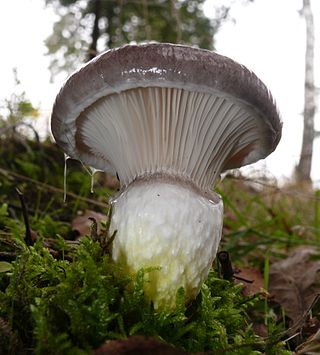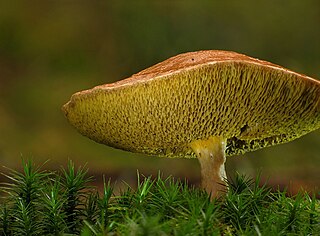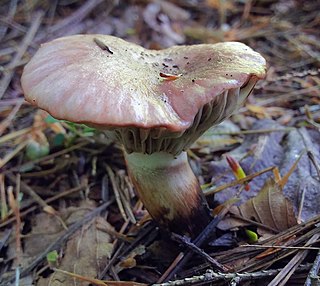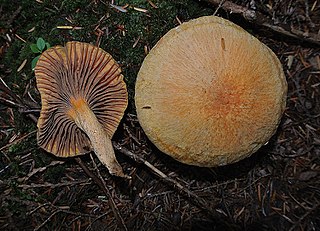
The Boletales are an order of Agaricomycetes containing over 1300 species with a diverse array of fruiting body types. The boletes are the best known members of this group, and until recently, the Boletales were thought to only contain boletes. The Boletales are now known to contain distinct groups of agarics, puffballs, and other fruiting-body types.

The Gomphidiaceae are a family of mushroom-forming fungi in the order Boletales. Unlike other boletes, all members of Gomphidiaceae are agarics, having gills instead of pores. Member genera include Chroogomphus, Cystogomphus, Gomphidius and Gomphogaster, the last being a monotypic genus that may be incorporated into Gomphidius in the future after molecular assessment. The similarly named genus Gomphus is unrelated to this family. Another genus Brauniellula has since been sunk into Chroogomphus.

Gomphidius is a genus of mushrooms, commonly known as spike-caps, that are members of the Boletales, or pored fungi. They appear to have gill-like structures which resemble those of agarics, however the similarity is superficial only. The best-known member is the slimy spike-cap. The genus has a widespread distribution, especially in north temperate areas, and contains 10 species.

Suillus bovinus, also known as the Jersey cow mushroom or bovine bolete, is a pored mushroom of the genus Suillus in the family Suillaceae. A common fungus native to Europe and Asia, it has been introduced to North America and Australia. It was initially described as Boletus bovinus by Carl Linnaeus in 1753, and given its current binomial name by Henri François Anne de Roussel in 1806. It is an edible mushroom, though not highly regarded.

Chroogomphus rutilus, commonly known as the brown slimecap or the copper spike, is a species of fungus in the Gomphidiaceae family. First described scientifically as Agaricus rutilus by Jacob Christian Schäffer in 1774, it was transferred to the genus Chroogomphus in 1964 by Orson K. Miller, Jr. The fungus lives ectomycorrhizally with Pinus species, and is found in Europe and North America. The fruit bodies are edible but not highly regarded.

Chroogomphus is a genus of mushrooms commonly known as pine-spikes or spike-caps based on their shape and because they are often found growing in association with pine trees. The genus is distributed throughout the Northern Hemisphere including North America and Eurasia.

Chroogomphus vinicolor, commonly known as the wine-cap Chroogomphus or the pine spike, is a species of mushroom in the family Gomphidiaceae. Found in North America and the Dominican Republic, mushrooms grow on the ground under pine trees. Fruit bodies have reddish-brown, shiny caps atop tapered stems. The gills are thick, initially pale orange before turning blackish, and extend a short way down the length of the stem. Although the mushroom is edible, and sold in local markets in Mexico, it is not highly rated. Distinguishing this species from some other similar Chroogomphus species is difficult, as their morphology is similar, and cap coloration is too variable to be a reliable characteristic. C. vinicolor is differentiated from the European C. rutilus and the North American C. ochraceus by the thickness of its cystidial walls.

Gomphidius roseus, commonly known as the rosy spike-cap or pink gomphidius, is a gilled mushroom found in Europe. Although it has gills, it is a member of the order Boletales, along with the boletes. It is a coral pink-capped mushroom which appears in pine forests in autumn, always near the related mushroom Suillus bovinus, on which it appears to be parasitic.

Gomphidius glutinosus, commonly known as the slimy spike-cap, hideous gomphidius, or glutinous gomphidius is a gilled mushroom found in Europe & North America. Although it has gills, it is a member of the order Boletales, along with the boletes. The fruiting bodies sprout in pine, fir and spruce woodland in Europe in autumn. Initially, are completely covered with a slimy veil, breaking through to reveal a greyish or brownish-capped mushroom with decurrent greyish gills which sometimes resembles a child's top. Opinions differ on the suitability of this mushroom for the table, some guides hold it in high regard, while others view it with caution.

Gomphidius oregonensis, commonly known as insidious gomphidius, is a mushroom found only in western North America, most commonly on the Pacific Coast. G. oregonensis can be distinguished by its spores which are the shortest in the genus, typically less than 14 μm long. Earlier in growth, G. oregonensis can be difficult to distinguish from other members of the genus Gomphidius, such as G. glutinosus, which is the most common and widespread species. With age, the fruiting body becomes murky and "insidious" in appearance, hence its common name.

Boletinellus merulioides, commonly known as the ash-tree bolete, is a species of bolete fungus in the family Boletinellaceae. Described as new to science in 1832, it is found in Asia and eastern North America, where it grows on the ground near ash trees.

Gomphidius subroseus, commonly known as the rosy gomphidius is a gilled mushroom found in Europe and North America. It was first described by Calvin Henry Kauffman in 1925. It was once thought to be mycorrhizal with Pinus sylvestris. However, Olson et al. (2002) found it to be more likely to be parasitic on Suillus bovinus, which is mycorrhizal with Pinus sylvestris, Pinus sylvestris or both. It is considered edible but of low quality. As with other species of the genus, removing the glutinous cuticle improves the taste.
Gomphogaster is a fungal genus in the family Gomphidiaceae. Circumscribed in 1972 by American mycologist Orson K. Miller, Jr., the genus is monotypic, containing the single gasteroid species Gomphogaster leucosarx, found in the United States.

Gomphidius largus is a fungus native to North America.

Gomphidius maculatus is an edible mushroom in the family Gomphidiaceae that is found in Europe and North America. It was first described scientifically by naturalist Giovanni Antonio Scopoli in 1772. Elias Magnus Fries transferred it to the genus Gomphidius in 1838, giving it the name by which it is known today. The specific epithet maculatus is derived from the Latin word for "spotted".

Gomphidius nigricans is a mushroom in the family Gomphidiaceae that is found in eastern North America to as far west as Michigan.

Gomphidius smithii is an edible mushroom in the family of Gomphidiaceae that is found in the Pacific Northwest in North America.
Gomphidius pseudoflavipes is a mushroom in the family Gomphidiaceae that is found in California in North America.
Gomphidius borealis is a mushroom in the family Gomphidiaceae that is found in Siberia.

Chroogomphus ochraceus is a species of fungus from the family Gomphidiaceae. Known for its close association with conifer trees–especially pines, it is often referred to as the "pine spike" or "spike cap" fungus. C. ochraceus was originally identified as a species limited to the Pacific Northwest because of its display of distinct yellowish colors, but recent research has concluded that this species is widespread across North America and that it is genetically distinct from Chroogomphus rutilus, which is limited to Europe.













